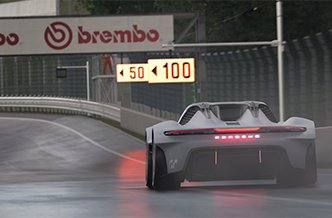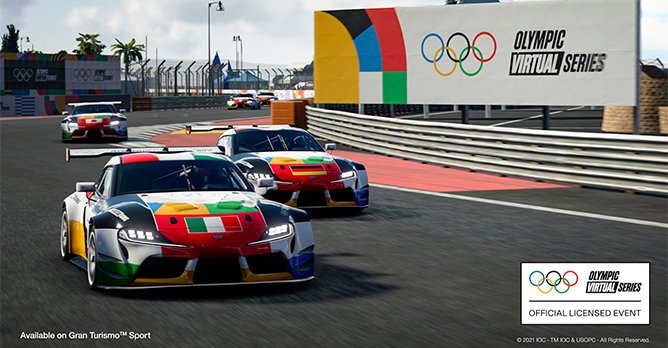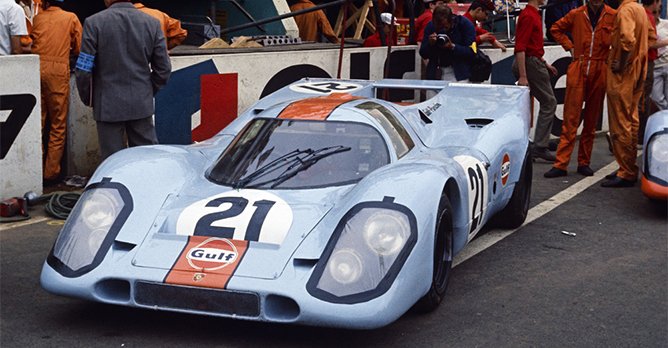A present to the gaming community: There's a good reason why the Porsche Vision GT car took so long
07 Dec 2021|1,519 views
Was there ever a point where Porsche's Vision GT car was headed towards adopting a combustion-engine in any form - hybridised, turbocharged or naturally aspirated? Perhaps an augmented version of the brand's iconic flat-six?
No. Apparently not.
Four years after the Stuttgart-based automaker announced it was finally bringing its well-loved cars into Gran Turismo, PlayStation's bestselling racing simulation franchise, its Vision GT car has been unveiled in full.
The result of two and a half years of painstaking designing both in-house and in collaboration with Polyphony Digital is this: The breathtakingly futuristic yet somewhat familiar silhouette of a two-seater lightweight racer, curves and rounded wheel arches galore. It's also fully electric.
"[This is] our take on the electric motorsports car of the future", Deniz Keskin, the project's leader and Head of Branded Management at Porsche explains. "A rather compact, very nimble and agile car - the way we would build a Porsche."
When it finally debuts in-game come March 2022, the car will boast a theoretical peak performance of 820kW from an 87kWh battery, which can then get bumped up to an eye-watering 920kW with overboost power (the equivalent of more than 1200bhp). Top speed will be 350km/h, while the car will blast off into three-digit territory in less than 2.1 seconds (0 to 200km/h takes less than 5.4 seconds).
Naysayers may scoff at such preciseness for a car that technically won't exist in real life, but both Keskin and Sebastian Hornung, Manager for Branded Entertainment at Porsche, insist that the numbers aren't arbitrary. "Of course… we can't test it in real life, but these figures have really been - if you like - calculated scientifically, so it's not just something that we kind of put on paper. We looked at the size of the battery; what we think is technically possible."
Notably too, these aren't incredibly far-fetched numbers for an electric racecar in an era where 'entry-level' electric sedans are doing 0-100km/h in 3.3 seconds. Still, this general aura of realism is something the team has strived to achieve with the Vision GT, and in a manner faithful to Porsche. Keskin dismisses the notion of a brash and overpowered car, saying, "It's not about doing something huge with 5000hp, because that's not our brand."

"[Whether] your task is to, you know, convince aesthetically primarily, or whether you intend to make a really raceable car that is also gameable… that's kind of a different approach", Keskin points out.
Incredible detail has been paid not just to the driving dynamics of the car, but also the virtual driver's perspective. For instance, the interior is fully fleshed out and features a holographic heads-up display to 'deliver all the data [for the driver] in an easily digestible and efficient way'.
Meanwhile, Hornung explains that it was important to create a 'really powerful, low-hanging back' for the car, where the dynamics of driving - including the car's active aero and movable flaps when cornering - are highly visible. The intended result is a car that will hopefully feel life-like and responsive on a visual level as well.
It's no wonder then that the entire project took two and a half years to finally materialise in today's form. As evidence of the gravity with which the Vision GT car was approached, both Keskin and Hornung note that this timeline lines up with how the design team generally works on any of Porsche's other showcar prototypes.
Keskin appears confident that the team's 'thoroughness and dedication' to the car will show. "This is our nod, our present to the gaming community, and we've taken the lengths of a normal vehicle development process but we've done it specifically for this audience. And I think that says a lot about our appreciation for these people. And for Porsche, that's definitely a first."
In the meantime, the team is apparently working with up to 20 other publishers to strengthen Porsche's presence in the realm of e-motorsports. It's part of Weissach's efforts to create even more entry points into its brand, through reaching out to new fans and moving them with the sort of gravitas only possible with a Porsche, even if in a virtual space.
Keskin acknowledges that there is still a line between virtual and real-world racing - and hence, also the ever-present challenge of transfiguring the je ne sais quois of Porsches into less tangible forms. But the team is not shying away from it.
"It's mandatory that we find a way to translate the Porsche emotions and the Porsche soul into the digital sphere," he asserts. "We have to deliver on that."
It doesn't have to be a crutch either. Hornung adds, "You have to remember that games are the best emotional and interactive tool to really give a broad audience the experience of driving our cars. You can drive all sorts of historical cars or limited edition cars - 919 Hybrid Evo, 356, 962, whatever - and even cars that do not exist right now."
With the aggressive push into e-motorsports lately, the idea that we'll see a Porsche-only racing simulation game in the near future (in the vein of 2000's Need for Speed: Porsche Unleashed) is largely dismissed, but not ruled out entirely. "Let's see what the future brings; maybe we'll find a good way through a certain anniversary, or certain touchpoints where we believe it makes sense," Hornung says.
Besides, until that happens, the team doesn't seem too bothered about letting Porsche's motorsports legends mingle with the competition. With an audible smirk, Keskin chirps, "Personally, you know, I also love it if there are other brands in the game… and we win against them."
Was there ever a point where Porsche's Vision GT car was headed towards adopting a combustion-engine in any form - hybridised, turbocharged or naturally aspirated? Perhaps an augmented version of the brand's iconic flat-six?
No. Apparently not.
Four years after the Stuttgart-based automaker announced it was finally bringing its well-loved cars into Gran Turismo, PlayStation's bestselling racing simulation franchise, its Vision GT car has been unveiled in full.
The result of two and a half years of painstaking designing both in-house and in collaboration with Polyphony Digital is this: The breathtakingly futuristic yet somewhat familiar silhouette of a two-seater lightweight racer, curves and rounded wheel arches galore. It's also fully electric.
"[This is] our take on the electric motorsports car of the future", Deniz Keskin, the project's leader and Head of Branded Management at Porsche explains. "A rather compact, very nimble and agile car - the way we would build a Porsche."
When it finally debuts in-game come March 2022, the car will boast a theoretical peak performance of 820kW from an 87kWh battery, which can then get bumped up to an eye-watering 920kW with overboost power (the equivalent of more than 1200bhp). Top speed will be 350km/h, while the car will blast off into three-digit territory in less than 2.1 seconds (0 to 200km/h takes less than 5.4 seconds).
Naysayers may scoff at such preciseness for a car that technically won't exist in real life, but both Keskin and Sebastian Hornung, Manager for Branded Entertainment at Porsche, insist that the numbers aren't arbitrary. "Of course… we can't test it in real life, but these figures have really been - if you like - calculated scientifically, so it's not just something that we kind of put on paper. We looked at the size of the battery; what we think is technically possible."
Notably too, these aren't incredibly far-fetched numbers for an electric racecar in an era where 'entry-level' electric sedans are doing 0-100km/h in 3.3 seconds. Still, this general aura of realism is something the team has strived to achieve with the Vision GT, and in a manner faithful to Porsche. Keskin dismisses the notion of a brash and overpowered car, saying, "It's not about doing something huge with 5000hp, because that's not our brand."

"[Whether] your task is to, you know, convince aesthetically primarily, or whether you intend to make a really raceable car that is also gameable… that's kind of a different approach", Keskin points out.
Incredible detail has been paid not just to the driving dynamics of the car, but also the virtual driver's perspective. For instance, the interior is fully fleshed out and features a holographic heads-up display to 'deliver all the data [for the driver] in an easily digestible and efficient way'.
Meanwhile, Hornung explains that it was important to create a 'really powerful, low-hanging back' for the car, where the dynamics of driving - including the car's active aero and movable flaps when cornering - are highly visible. The intended result is a car that will hopefully feel life-like and responsive on a visual level as well.
It's no wonder then that the entire project took two and a half years to finally materialise in today's form. As evidence of the gravity with which the Vision GT car was approached, both Keskin and Hornung note that this timeline lines up with how the design team generally works on any of Porsche's other showcar prototypes.
Keskin appears confident that the team's 'thoroughness and dedication' to the car will show. "This is our nod, our present to the gaming community, and we've taken the lengths of a normal vehicle development process but we've done it specifically for this audience. And I think that says a lot about our appreciation for these people. And for Porsche, that's definitely a first."
In the meantime, the team is apparently working with up to 20 other publishers to strengthen Porsche's presence in the realm of e-motorsports. It's part of Weissach's efforts to create even more entry points into its brand, through reaching out to new fans and moving them with the sort of gravitas only possible with a Porsche, even if in a virtual space.
Keskin acknowledges that there is still a line between virtual and real-world racing - and hence, also the ever-present challenge of transfiguring the je ne sais quois of Porsches into less tangible forms. But the team is not shying away from it.
"It's mandatory that we find a way to translate the Porsche emotions and the Porsche soul into the digital sphere," he asserts. "We have to deliver on that."
It doesn't have to be a crutch either. Hornung adds, "You have to remember that games are the best emotional and interactive tool to really give a broad audience the experience of driving our cars. You can drive all sorts of historical cars or limited edition cars - 919 Hybrid Evo, 356, 962, whatever - and even cars that do not exist right now."
With the aggressive push into e-motorsports lately, the idea that we'll see a Porsche-only racing simulation game in the near future (in the vein of 2000's Need for Speed: Porsche Unleashed) is largely dismissed, but not ruled out entirely. "Let's see what the future brings; maybe we'll find a good way through a certain anniversary, or certain touchpoints where we believe it makes sense," Hornung says.
Besides, until that happens, the team doesn't seem too bothered about letting Porsche's motorsports legends mingle with the competition. With an audible smirk, Keskin chirps, "Personally, you know, I also love it if there are other brands in the game… and we win against them."
Thank You For Your Subscription.





























